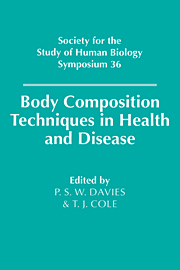Book contents
- Frontmatter
- Contents
- List of contributors
- 1 Application of dual-energy X-ray absorptiometry and related techniques to the assessment of bone and body composition
- 2 In vivo neutron activation analysis: past, present and future
- 3 Magnetic resonance imaging for the assessment of body composition
- 4 Multi-frequency impedance as a measure of body water compartments
- 5 Body composition assessed by electrical conductivity methods
- 6 Body composition in malnutrition
- 7 Influence of body composition on protein and energy requirements: some new insights
- 8 Prediction of adult body composition from infant and child measurements
- 9 Assessment of body composition in the obese
- 10 The role of body physique assessment in sports science
- 11 The assessment of the body composition of populations
- 12 Changes in approach to the measurement of body composition
- 13 Multi-compartment models for the assessment of body composition in health and disease
- 14 The future of body composition research
- Index
11 - The assessment of the body composition of populations
Published online by Cambridge University Press: 18 September 2009
- Frontmatter
- Contents
- List of contributors
- 1 Application of dual-energy X-ray absorptiometry and related techniques to the assessment of bone and body composition
- 2 In vivo neutron activation analysis: past, present and future
- 3 Magnetic resonance imaging for the assessment of body composition
- 4 Multi-frequency impedance as a measure of body water compartments
- 5 Body composition assessed by electrical conductivity methods
- 6 Body composition in malnutrition
- 7 Influence of body composition on protein and energy requirements: some new insights
- 8 Prediction of adult body composition from infant and child measurements
- 9 Assessment of body composition in the obese
- 10 The role of body physique assessment in sports science
- 11 The assessment of the body composition of populations
- 12 Changes in approach to the measurement of body composition
- 13 Multi-compartment models for the assessment of body composition in health and disease
- 14 The future of body composition research
- Index
Summary
Introduction
The measurement of body composition occurs in many branches of biology and medicine. It is measured by the human biologist studying human variation and adaptation and it is being used increasingly in the assessment of nutritional and growth status, fitness, work capacity, disease and its treatment. In human energetics, it is widely used for the standardisation of variables such as basal metabolic rate or physical work capacity in, for example, the investigation of the types and scope of adaptation to chronic energy and nutrient deficiency or excess.
Most determinations of body composition, whether for research or surveillance purposes, are made in the field as opposed to the laboratory or bedside. There is then a clear need for simple, rapid, safe, accurate methods to determine body composition in population studies. For many years anthropometry has, to some extent, met this need. Body composition has properties additional to those of size, i.e. weight and linear dimensions, but weight/height indices have been and continue to be used widely as proxies for body composition measurements. The best known of these is the Body mass index (BMI) or Quetelet's index.
Skinfold thicknesses stand in their own right as indices of fat and fatness and, by difference, of leanness. There are reference data for all ages and both sexes. The practice of estimating body composition from anthropometric variables is fraught with pitfalls as many of the published equations have not been proved to be of general validity.
- Type
- Chapter
- Information
- Body Composition Techniques in Health and Disease , pp. 195 - 221Publisher: Cambridge University PressPrint publication year: 1995
- 12
- Cited by

